Give pics a chance
Iconic protest photos that changed the world
Advertisement
Read this article for free:
or
Already have an account? Log in here »
To continue reading, please subscribe:
Monthly Digital Subscription
$1 per week for 24 weeks*
- Enjoy unlimited reading on winnipegfreepress.com
- Read the E-Edition, our digital replica newspaper
- Access News Break, our award-winning app
- Play interactive puzzles
*Billed as $4.00 plus GST every four weeks. After 24 weeks, price increases to the regular rate of $19.00 plus GST every four weeks. Offer available to new and qualified returning subscribers only. Cancel any time.
Monthly Digital Subscription
$4.75/week*
- Enjoy unlimited reading on winnipegfreepress.com
- Read the E-Edition, our digital replica newspaper
- Access News Break, our award-winning app
- Play interactive puzzles
*Billed as $19 plus GST every four weeks. Cancel any time.
To continue reading, please subscribe:
Add Winnipeg Free Press access to your Brandon Sun subscription for only
$1 for the first 4 weeks*
*$1 will be added to your next bill. After your 4 weeks access is complete your rate will increase by $0.00 a X percent off the regular rate.
Read unlimited articles for free today:
or
Already have an account? Log in here »
Hey there, time traveller!
This article was published 16/07/2016 (3338 days ago), so information in it may no longer be current.
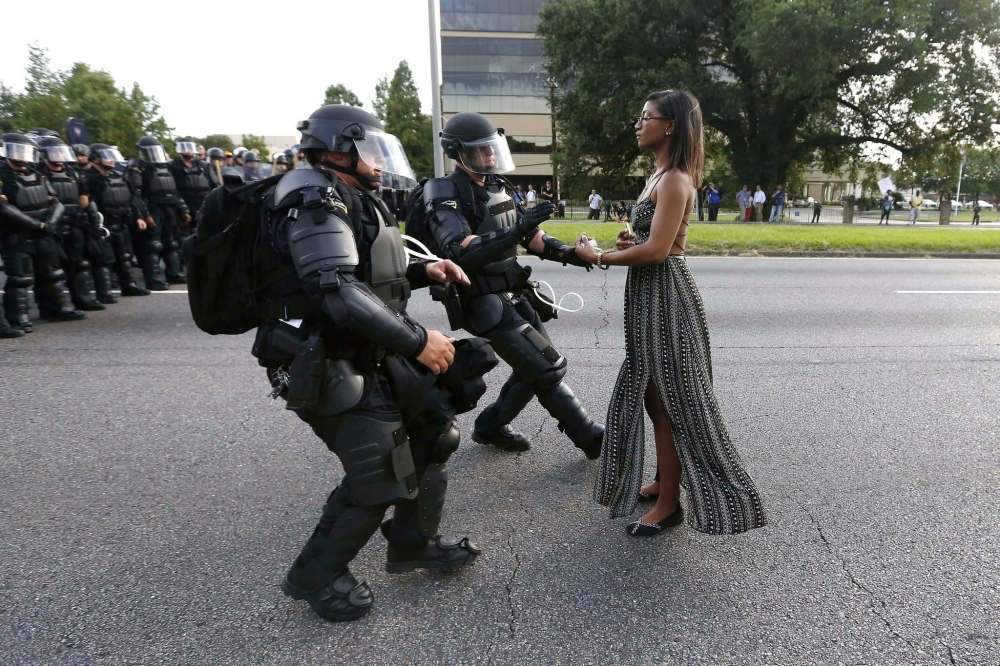
If you haven’t seen this photograph yet, you’re definitely in the minority.
From the moment it was posted last Saturday, it hit social media like a hurricane, becoming a viral symbol of the civil unrest that has spread across the United States following the police shooting deaths of two more black men.
The stunning image, taken by freelance photographer Jonathan Bachman for Reuters, shows a lone woman, identified as Iesha L. Evans, her arms extended, her long sun dress fluttering in the breeze, the calm at the centre of the storm as two heavily armed Louisiana state troopers in black riot gear charge towards her.
In the midst of a protest outside Baton Rouge police quarters, Bachman captured a strangely serene moment as Evans made her stand, seemingly refusing to budge while the officers rush out to arrest her.
Evans, reportedly a licensed practical nurse from Pennsylvania with a five-year-old son, was among more than 100 protesters detained on charges of obstructing the highway. She was later released from custody.
“You’ll be seeing this iconic photo from #BatonRouge & versions of it for the rest of your life,” a man named David Law said on Twitter this week. On her Facebook page, Evans called her actions “the work of God” and wrote: “I am a vessel! Glory to the most high! I’m glad I’m alive and safe.”
The photograph has drawn comparisons to other historic images, including our Top Five Protest Photos of All Time:
5) The iconic image: John and Yoko’s Bed-In
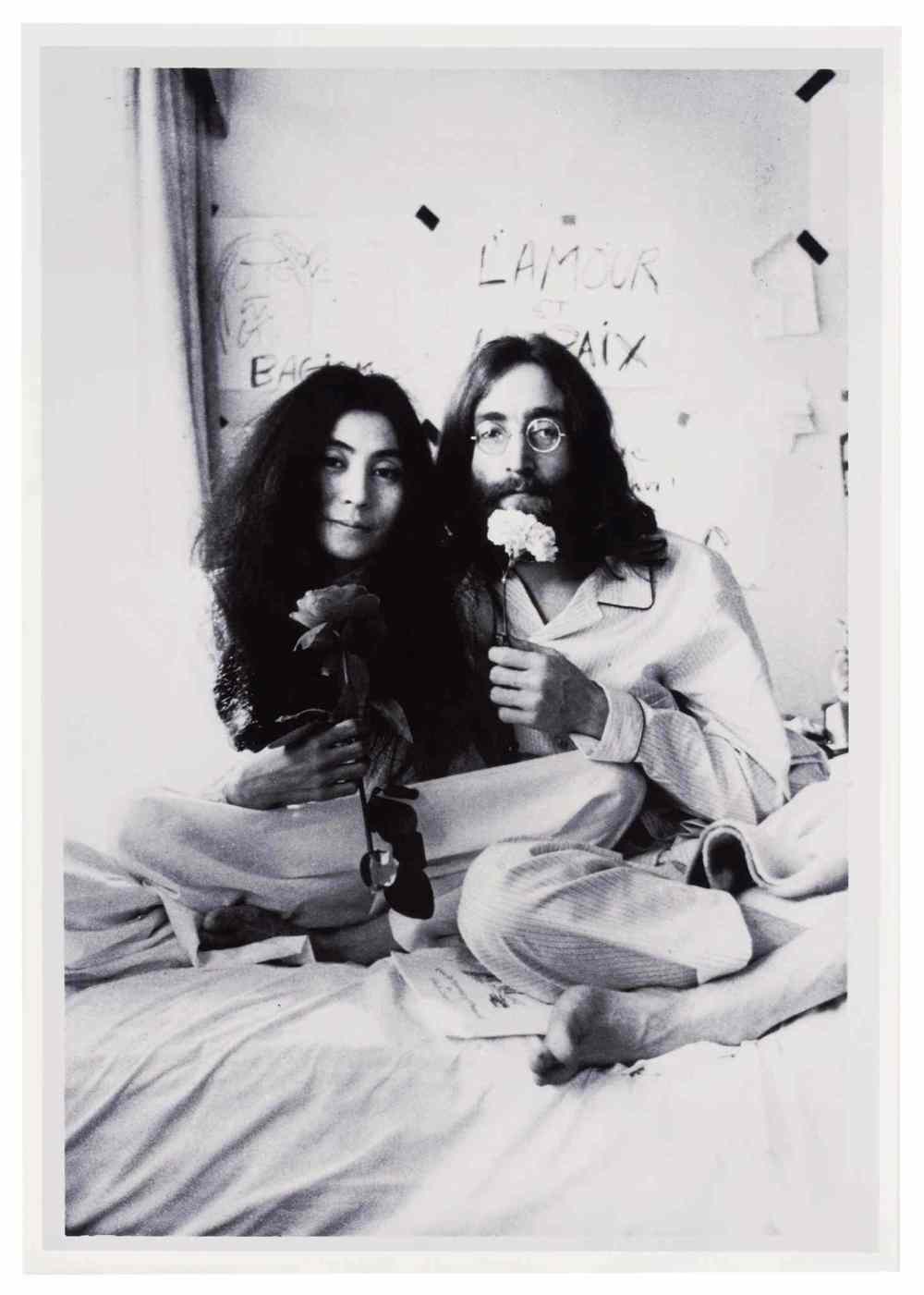
Behind the photo: Most newlyweds enjoy spending a little time in bed after their nuptials, but no one has ever done it quite like John and Yoko. The Beatles legend married his second wife, Yoko Ono, on March 20, 1969, and five days later, in lieu of a traditional honeymoon, the celebrity couple holed up in the bed of the Amsterdam Hilton’s presidential suite for their first week-long Bed-In for Peace to show their opposition to the Vietnam War. The couple invited global media into their room — decorated with hand-drawn signs above their bed reading “Hair Peace” and “Bed Peace” — and talked about peace for 12 hours every day.
“You should have seen the faces on the reporters and the cameramen fighting their way though the door,” John recalled later. “They fought their way in, and their faces dropped. There we were like two angels in bed, with flowers all around us, and peace and love on our heads. We were fully clothed; the bed was just an accessory.”
Two months later, they moved their protest to Montreal’s Queen Elizabeth Hotel, famously occupying a suite of rooms and inviting dozens of friends, journalists and hangers-on — everyone from Timothy Leary to Tommy Smothers — to drop by during the day.
The second Bed-In was supposed to take place in New York, but Lennon wasn’t allowed into the U.S. because of a 1968 cannabis conviction. In Montreal, Lennon and a few friends famously recorded the song Give Peace a Chance. Lennon banged the tune out in 15 minutes, or, as Dave Patrick wrote in a 1969 article for Weekend magazine, “just slightly less than the time it takes you or me to write out the grocery list.”
4) The iconic image: Face to face at Oka
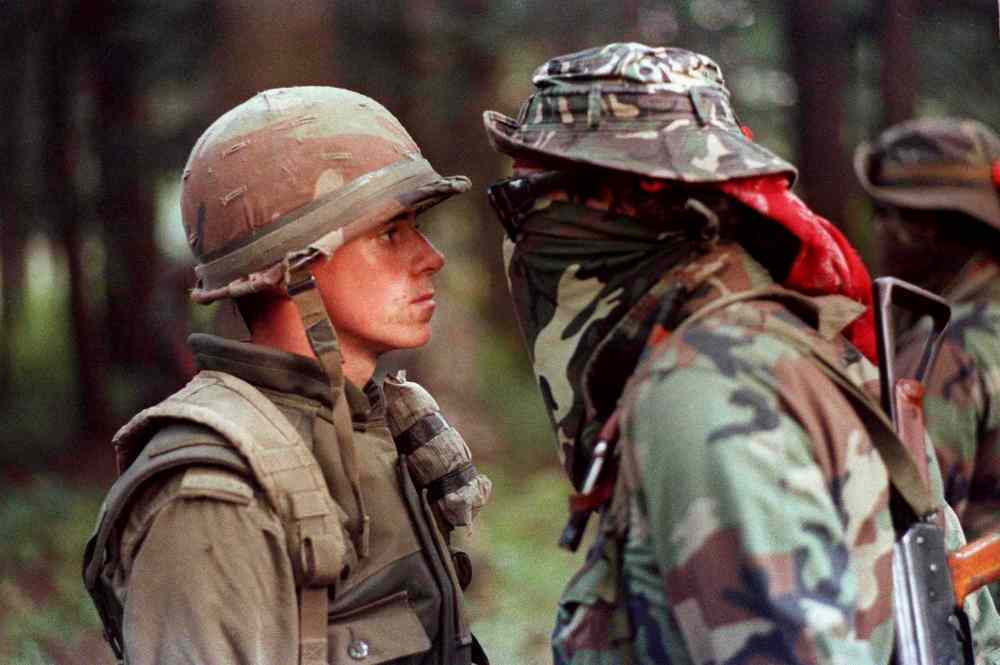
Behind the photo: It has been described as “one of the few Canadian photos that comes close to being iconic,” and some have called it Canada’s most famous image. It’s the unforgettable photo of Canadian soldier Pte. Patrick Cloutier and Anishinaabe warrior Brad (Freddy Krueger) Larocque staring each other down in a tense standoff at the Kahnesatake reserve in Oka, Que., on Sept. 1, 1990.
The Oka crisis was a 78-day standoff between Mohawk protesters, police and the army triggered by the proposed expansion of a golf course and development of condos on disputed land that included a Mohawk burial ground. It is considered the first well-publicized violent conflict between a First Nations community and the Canadian government in the late 20th century. In a bid to halt development, Mohawk protesters erected a barricade blocking access to the area.
The barricade was later attacked by the Sûreté du Quebec and, during a brief gunfight, Cpl. Marcel Lemay was killed by a bullet whose source has never been officially determined. With the Sûreté du Quebec unable to resolve the crisis, the province requested the help of the army. On Aug. 20, about 800 members of the Royal 22e Regiment assumed a position mere metres from the warriors.
On Sept. 1, Shaney Komulainen, working as a freelance photographer for The Canadian Press, made her way to the front lines and captured the historic confrontation. At least three warriors approached the young soldier, but the photo shows him and Larocque, a Saskatchewan student who came to the First Nation to support the Mohawk, going beak to beak.
“It just struck me that his (Cloutier’s) face was so young,” Komulainen said later. “He was military, but he was so young.” Quebec media dubbed Cloutier “the little soldier staring unblinkingly at the angry warrior.”
The photo was used as a recruitment tool by the Canadian Forces. Photographer Robert Galbraith, who also shot the crisis, has called it among the top five Canadian photos ever taken.
3) The iconic image(s): Flower Power
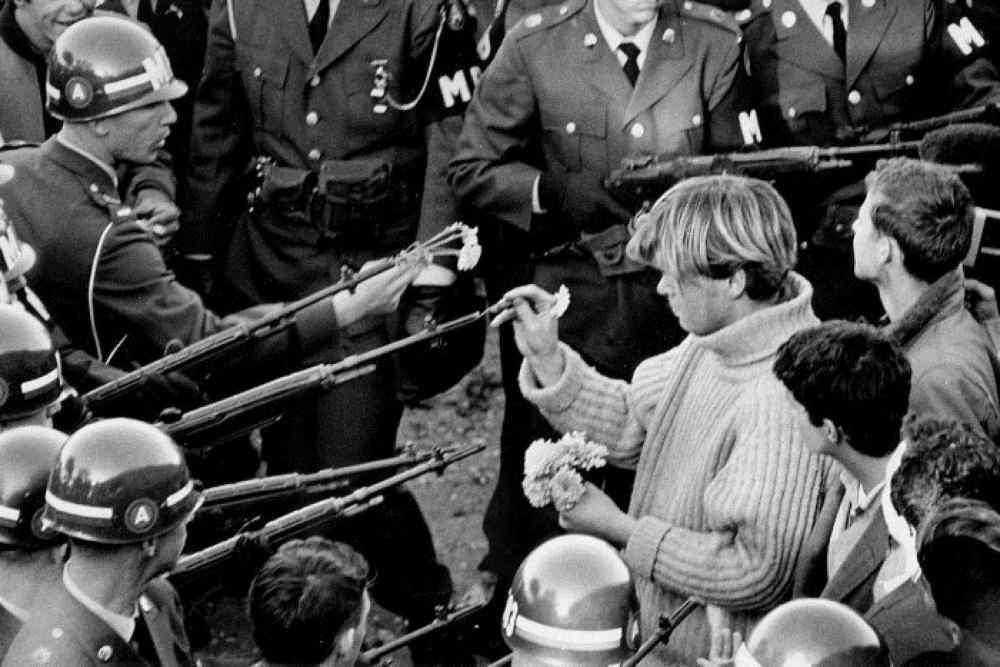
Behind the photo: One massive demonstration, two iconic photos. When an estimated 250,000 demonstrators descended on the Pentagon on Oct. 21, 1967, to protest the Vietnam War, photographer Bernie Boston, working for the now-defunct Washington Star, was happily perched on top of a wall of the Mall entrance, which is when he spotted a lieutenant march a squad of national guardsmen into the crowd of protesters.
The squad formed a semicircle around some protesters, at which point a young long-haired man in a turtleneck sweater emerged from the crowd and began placing carnations into the barrels of the soldiers’ rifles. The picture, which Boston dubbed “Flower Power,” became one of the most reprinted photos of the era, appearing in government textbooks and TV specials about the time. It was nominated for the 1967 Pulitzer Prize, but at the time Boston couldn’t persuade his editors of the photo’s importance, so they buried it inside the front section.
By most accounts, the flower-wielding protester was George Harris, an 18-year-old actor from New York. It sums up the era — carnations in gun barrels. Equally famous is the photo French photographer Marc Riboud snapped that day of Jan Rose Kasmir, then a 17-year-old Washington-area high school student, holding a flower in the face of bayonets.
According to a 1999 special edition of Life magazine, the photo became “an enduring icon of the anti-war movement.”
The rally resulted in violent clashes, with 681 protesters arrested and dozens beaten.
2) The iconic image: The Black Power Salute
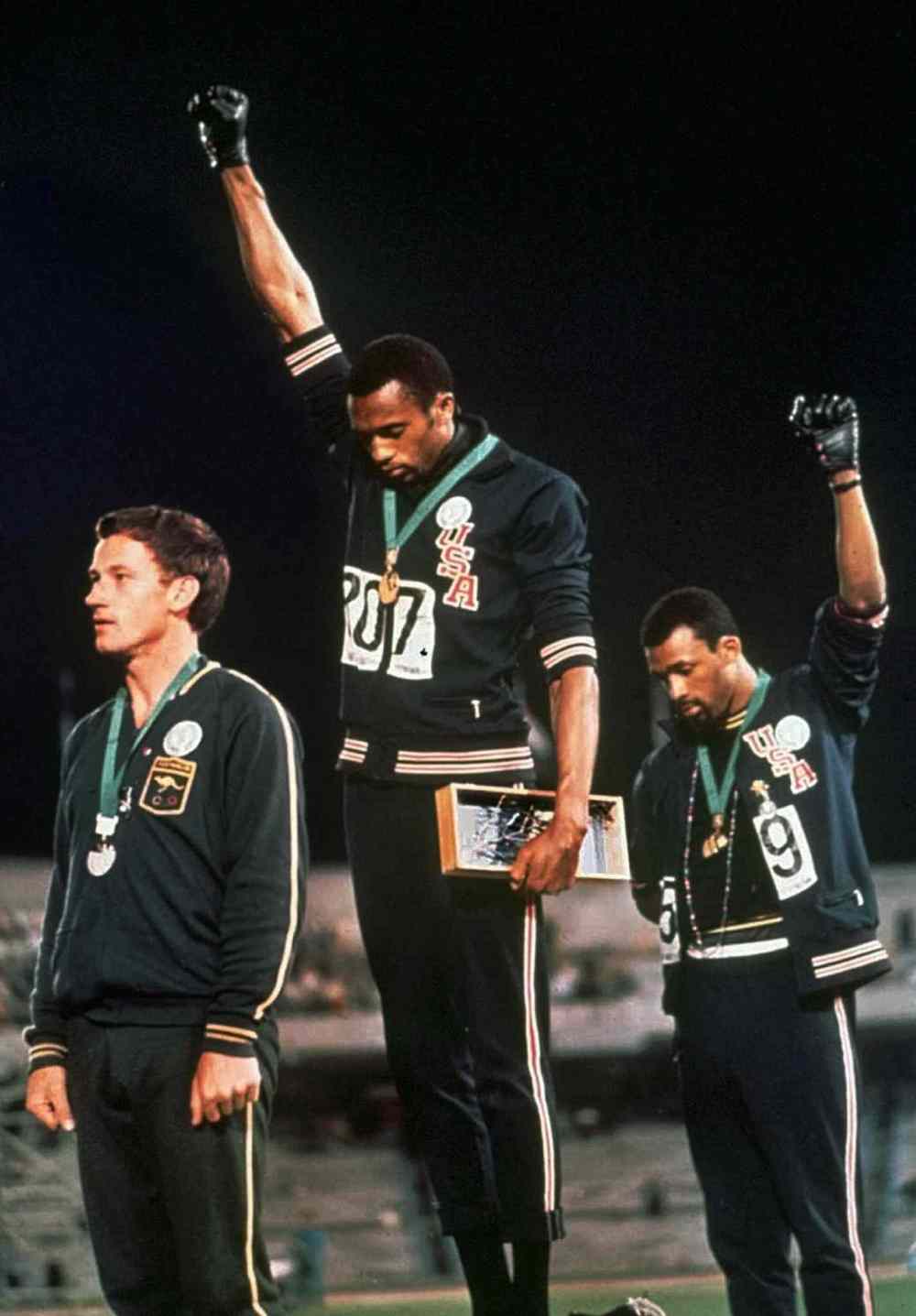
Behind the photo: It is one of the most iconic protest photos in history, even if the man who was behind the camera lens didn’t think it was such hot stuff at the time. On Oct. 16, 1968, at the Summer Olympics in Mexico City, black American sprinters Tommie Smith and John Carlos mounted the podium to accept their 200-metre medals (gold for Smith, bronze for Carlos).
As the national anthem began to play, the pair took their political message to the highest level of sport, bowing their heads and each raising a single black-gloved fist and keeping them raised until the anthem was finished. They accepted their medals shoeless, wearing black socks to symbolize black poverty. It was a silent protest heard around the world. In the racially charged 1960s, the reaction was immediate and harsh.
Allowed to keep their medals, the pair were kicked out of the Olympics and vilified at home. “We were just human beings who saw a need to bring attention to the inequality in our country,” Smith said years later in a documentary for HBO. Their gesture is now viewed as one of the most eloquent statements ever made in the fight for racial equality. It was initially dubbed a Black Power salute, but the two later said it was a call for human rights reform everywhere.
The historic image was captured by famed American photojournalist John Dominis. “I didn’t think it was a big news event,” Dominis told Smithsonian magazine in 2008. “I hardly noticed what was happening when I was shooting.” He also dismissed his black-and-white picture as “not much of a photograph.”
It was a milestone in the long, painful journey toward civil rights. So, yeah, not much of a photograph.
1) The iconic image: Tank Man

Behind the photo: It is one of the most powerful images of the 20th century, although a lot of folks in China have never been allowed to see it. In mid-1989, students began gathering in Beijing’s Tiananmen Square to mourn the passing of pro-democracy leader Hu Yaobang.
Over the course of seven weeks, Time.com notes, people from all walks of life joined the group to demand greater freedom. On June 5, the Chinese government deployed tanks to squelch the growing dissent, which is when a lone, defiant man — wearing a white shirt, black trousers and holding a shopping bag — strode into the middle of the wide avenue, directly in the path of the line of tanks. He weaved from side to side to block their progress, at one point even climbing atop the lead tank in an apparent attempt to chat with the crew inside. He was later seen on video footage being pulled away into the nearby crowd by two figures dressed in blue.
Many believe he was executed, though some have claimed he is hiding in Taiwan. Many in China remain unaware of Tank Man’s exploits, as only a handful of photographers were able to record the event without having to destroy their film. One of the best-known photos was taken by Stuart Franklin for Time and Life magazines.
His film was reportedly smuggled out of the country by a French student, concealed in a box of tea. Arguably the most-famous shot was taken by Jeff Widener of The Associated Press, who was on a sixth-floor balcony of the Beijing Hotel about 800 metres away. He didn’t think the shot was very good, but it was nominated for the Pulitzer Prize.
Another photographer, Newsweek’s Charlie Cole, hid his roll of film in a Beijing Hotel toilet. It is considered one of the 100 photos that changed the world.
There are many other photos that could be added to this historic list. We are lucky that in the midst of chaos, photojournalists have heroically captured moments forever held in time. A picture is said to be worth 1,000 words, but sometimes they say a lot more than that.
doug.speirs@freepress.mb.ca

